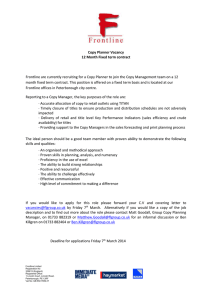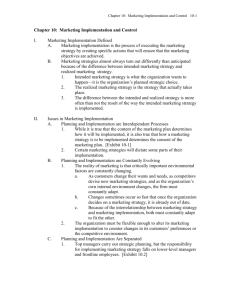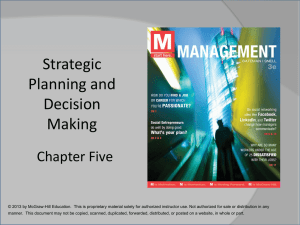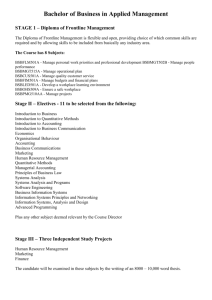Chapter 2
advertisement
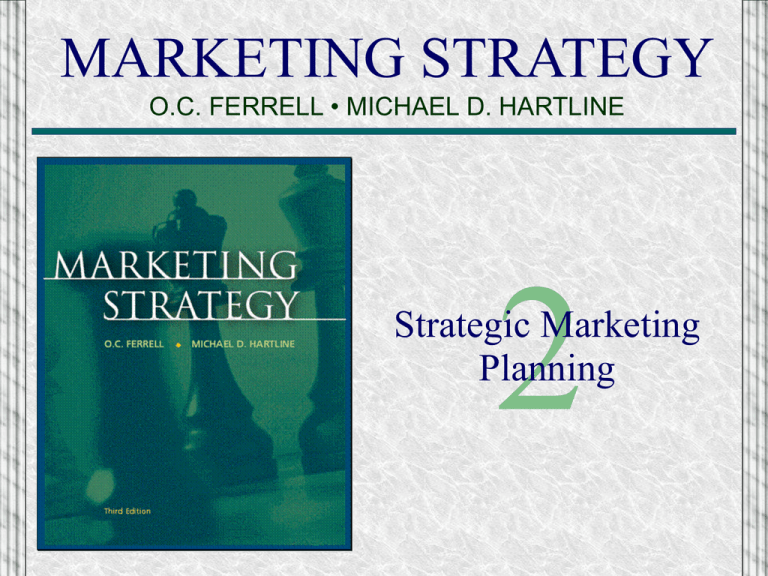
MARKETING STRATEGY O.C. FERRELL • MICHAEL D. HARTLINE 2 Strategic Marketing Planning The Strategic Planning Process • Marketing Plan – “…a written document that provides the blueprint or outline of the organization’s marketing activities, including the implementation, evaluation, and control of those activities.” 2-2 Discussion Question • What role, if any, should customers play in the strategic planning process? Should they have a voice in developing the organizational mission, marketing goals, or the marketing strategy? 2-3 Exhibit 2.1 2-4 Organizational Mission vs. Organizational Vision (1 of 2) • Elements of the Mission Statement – Five basic questions to be answered: • Who are we? • Who are our customers? • What is our operating philosophy? • What are our core competencies or competitive advantages? • What are our concerns and interests related to our employees, our community, society in general and our environment? 2-5 Organizational Mission vs. Organizational Vision (2 of 2) • Mission Width and Stability – Width: Too broad or too narrow? – Stability: Frequency of modifications • Customer-Focused Mission Statements – Ben and Jerry’s 3-part Mission Statement • Product Mission • Economic Mission • Social Mission – Tylenol 2-6 Marketing Strategy in Action • As this 1946 ad demonstrates, railways were once a prominent way to travel across the country. • How did narrow mission statements lead to missed opportunities for the railroad industry? 2-7 Ben & Jerry’s 3 Part Mission 2-8 Corporate or Business-Unit Strategy • Business-Unit Strategy: – The central means for: • Utilizing and integrating the organization’s resources • Carrying out the organization’s mission • Achieving the organization’s desired goals and objectives – Associated with developing a competitive advantage – Determines the nature and future direction of each business unit – Essentially the same as corporate strategy in small businesses 2-9 Functional Goals and Objectives • All business functions must support the organization’s mission and goals. • Functional objectives should be expressed in clear, simple terms. • All functional objectives should be reconsidered for each planning period. 2-10 Functional Strategy • Functional strategies are designed to integrate efforts focused on achieving the area’s stated objectives. • The strategy must: – (1) Fit the needs and purposes of the functional area – (2) Be realistic with the organization’s resources and environment – (3) Be consistent with the organization’s mission goals, and objectives. • The effects of each functional strategy must be evaluated. 2-11 Implementation • Involves activities that execute the functional strategy. • Functional plans have two target markets: – (1) External market – (2) Internal market • A company must rely on its internal market for a functional strategy to be implemented successfully. 2-12 Discussion Question • Defend or contradict this statement: Developing marketing strategy is more important than implementing marketing strategy because if the strategy is flawed, it doesn’t matter how well it is implemented. 2-13 Evaluation and Control • Designed to keep activities on target with goals and objectives • Coordination among functional areas is a critical issue – Open lines of communication is the key • Evaluation and control is both an ending and beginning: – Occurs after a strategy has been implemented – Serves as the beginning point for planning in the next cycle 2-14 The Marketing Plan • Detailed formulation of the actions needed to carry out the marketing program • An action document: – The handbook for marketing implementation, evaluation and control • Not the same as a business plan • Requires a great deal of information from many different sources 2-15 Marketing Plan Structure (1 of 5) • Should be well organized • A good marketing plan outline is: – Comprehensive – Flexible – Consistent – Logical 2-16 Marketing Plan Structure Exhibit 2.3 2-17 Marketing Plan Structure (2 of 5) • I. Executive Summary – Synopsis of the overall marketing plan – Introduces major aspects of the marketing plan • II. Situation Analysis – Summarizes information about 3 key environments: • Internal environment • Customer environment • Firm’s external environment 2-18 Marketing Plan Structure (3 of 5) • III. SWOT Analysis – – – – – – Strengths Weaknesses Opportunities Threats Analysis of the SWOT matrix Establishing a strategic focus 2-19 Marketing Plan Structure (4 of 5) • IV. Marketing Goals and Objectives: – Formal statements of desired and expected outcomes of the marketing plan – Goals: • Broad, simple statements of what is to be accomplished – Objectives • More specific and essential to planning • V. Marketing Strategy: – Primary target market and marketing mix – Secondary target market and marketing mix 2-20 Marketing Plan Structure (5 of 5) • VI. Marketing Implementation – – – – – – 1. What specific marketing activities will be undertaken? 2. How will these activities be performed? 3. When will these activities be performed? 4. Who is responsible for the completion of these activities? 5. How will the completion of planned activities be monitored? 6. How much will these activities cost? • VII. Evaluation and Control – Formal marketing control – Informal marketing control – Financial assessments 2-21 Using the Marketing Plan Structure • Tips for using the marketing plan framework to develop a marketing plan: – Plan ahead – Revise, revise, revise – Be creative – Use common sense and judgment – Think ahead to implementation – Update regularly – Communicate with others 2-22 Purposes and Significance of the Marketing Plan • A good marketing plan will: – (1) Explain both the present and future situations of the organization – (2) Specify the outcomes that are expected – (3) Describe the specific actions that are to take place – (4) Identify the resources that will be needed – (5) Permit the monitoring of each action and its results • Communicating the strategy to top executives is paramount. 2-23 Organizational Aspects of the Marketing Plan • Top managers ask two questions: – (1) Will the marketing plan achieve the desired goals and objectives? – (2) Are there alternative uses of resources that would better meet objectives? • The marketing plan is most often prepared by the Marketing Director or VP of Marketing • The final approval lies with the President, Chairman or CEO 2-24 Major Problems in Developing and Implementing the Marketing Plan Exhibit 2.4 2-25 Apple’s Changing Strategic Focus 2-26 Strategic Planning in the Market-Oriented Organization • A Market-Oriented Organization: – Shifts its focus: • From products to the requirements of market segments • From transactions to relationships • From competition to collaboration – Puts customer’s needs and wants first – Focuses on long-term, value-added relationships – Instills a corporate culture that puts customers at the top of the organizational hierarchy – Cooperates with suppliers and competitors to serve customers better 2-27 Traditional Organizations CEO CEO Competition Middle Managers Frontline Employees Middle Managers Frontline Employees Customers Exhibit 2.5 – Part One 2-28 Market-Oriented Organizations Customers Frontline Employees Middle Managers Frontline Employees Cooperation CEO Middle Managers CEO Exhibit 2.5 – Part Two 2-29 Discussion Question • In many organizations marketing is not given a place of importance in the organizational hierarchy. Why do you think this happens? What other business functions get more importance? Why? 2-30


